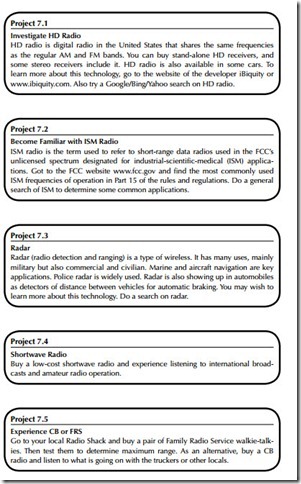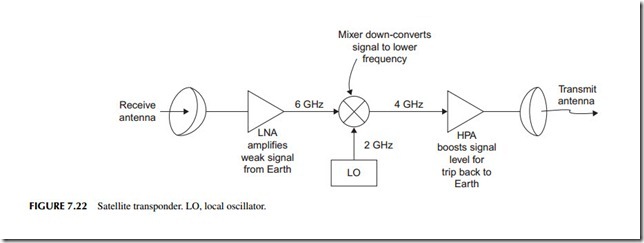RADIO TELESCOPES
Observation of the planets and stars is usually done with an optical telescope. However, in 1932 researchers discovered that distant stars or suns emit- ted radio waves. All stars, like our Sun, emit radio frequencies. Most of this energy occurs in the microwave region at 1.4218 GHz. This is the frequency of ionized hydrogen. By building a highly sensitive radio receiver and coupling it to a large highly directional radio antenna, it is possible to plot the position of distant stars just as effectively as an optical telescope. Radio telescopes are, in fact, even more effective in that they can more easily detect distant stars that cannot be seen even by the best optical telescopes.
Radio astronomy observatories consist of an enormous parabolic dish antenna usually 60 to 250 feet in diameter, which can be rotated and tilted so that it scans the skies. An array of multiple smaller dishes can also be used as in the SETI (search for extraterrestrial intelligence) project in New Mexico. The antennas are coupled to one or more very sensitive radio receivers. These
receivers have very high gain so that they can sufficiently amplify very small signals received from stars that are many light years away. Often special cool- ing systems are used to reduce the temperature of the receiver front end to minimize noise, thereby permitting even weaker signals to be received. The largest radio telescope is a parabolic dish reflector built of screen mesh 1000 feet in diameter. The dish is built into the valley between adjacent mountains near Arecibo, Puerto Rico. The horn antenna is moveable on a long cable so it can be positioned to see any part of the sky.
Wireless Everything
It seems like everything is going wireless these days. Cordless telephones, wireless local area networks, and your TV remote control. But wireless has always been around just not by that name. Most radio applications are old and well known. A few examples you may have encountered follow.
Garage door opener. A tiny transmitter in your car transmits a binary coded message to the receiver in your garage hooked up to the door motor.
Remote keyless entry. A miniature transmitter on your key ring transmits a signal to a receiver in your car that opens the door locks. Some even turn on lights and start your car from 10 to 30 feet away.
Wireless data acquisition. Remote transmitters are set up with solar batteries at remote sites to gather data from sensors and transmit it back to a collection center. A good example is electric, gas, and water utilities that use such systems to monitor critical conditions at remote sites and transmit the data back to a central monitoring facility where decisions can be made. Home wireless thermometers are very common.
Radio control of models. This is very common in toy cars, model airplanes, and boats.
RFID. Ultra miniature radios are being embedded in shipping labels, cars, and other objects for identification purposes. The units transmit their unique ID code when scanned by a nearby receiver.
HD radio. This is digital radio broadcasting in the United States. Most U.S. AM and FM stations now transmit a digital version of their signals on the same frequencies as their analog transmissions. They use a form of digital modulation called OFDM (see Chapter 8). It produces greater frequency response than the regular analog broadcasts, making AM sound more like FM and FM sound more like a CD. A special radio is needed to receive it. The digital technology makes noise and fading less of a problem. And it permits each station to add several additional channels thanks to the multiplexing capabilities of the HD technology. Security tag.sThe plastic tags clipped on new clothes to prevent their being stolen contain a tiny antenna and electronic circuit that make their presence known at a nearby transmitter/receiver unit.
Surveillance and bugging, or secret monitoring or electronic spying. This is not just something you see in the movies or on TV. It is more widely used in private investigation, police work, and industrial espionage than you may think. Scary. Face it, wireless is truly everywhere.
